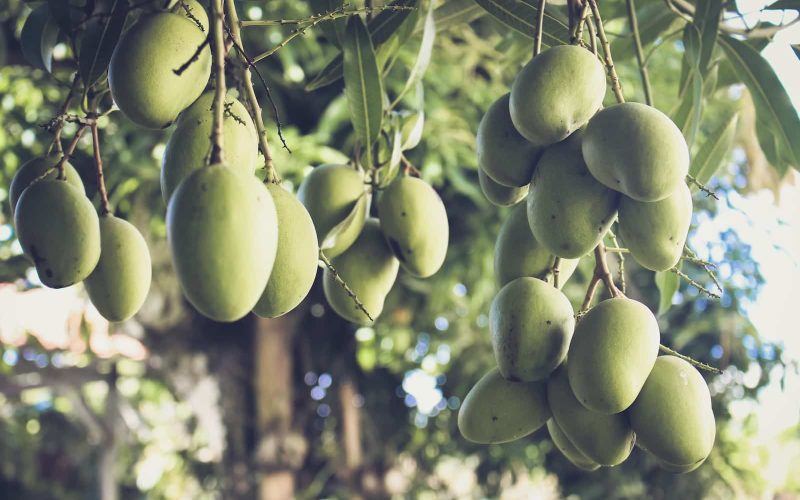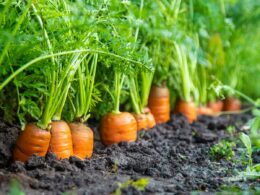Mangoes are a delicious piece of fruit people love all over the world. They add sweetness to any meal and are integral to almost every tropical country.
This article will help you understand the different types of mangoes available.
Cultivation of Mangoes does not start recently but for over 4,000 years. The Mughals would fight over the best mangoes, but you don’t have to.
However, if you need help determining which mango is the best for you, this article will show you some different types of mangoes for the best experience.
Different Types of Mangoes
1. Francis
Francis mango is a popular cultivar with a sweet and rich flavor, juicy texture, and distinct aroma.
It is one of the many different types of mangoes people grow and enjoy worldwide.
Here are some of the characteristics of Francis mango:
- Shape: Francis mango is oval-shaped, with a slightly flattened base and a pointed apex. It is medium to large, typically weighing between 16 and 32 ounces.
- Skin: The skin of Francis mango is green when unripe but turns yellow with a red blush when ripe. The skin is thin and smooth, with small, white dots on the surface.
- Flesh: The flesh of Francis mango is yellow-orange, tender, and juicy, with a fiberless texture. It has a rich, sweet, and aromatic flavor often described as “buttery.”
- Season: The season for Francis mango is typically from late May to early July, although the exact timing can vary depending on the region.
2. Haden
Haden is a mango cultivar that originated in Florida, United States. It is a medium to large-sized mango with an oval or oblong shape and a distinct S-shaped curvature.
The skin of a Haden mango is bright green with occasional red or yellow blushes, and it turns yellow-orange when it is ripe.
The flesh of a Haden mango is thick and juicy, with a vibrant yellow-orange color.
It has a sweet and slightly tart flavor with a subtle tropical aroma. The texture is smooth and firm, with minimal fiber.
Haden mangoes are typically available from April to July in the United States.
They use them primarily for fresh consumption, juicing, and as ingredients in various desserts, such as smoothies, sorbets, and cakes.
However, they export them to other countries, mainly Europe and Asia.
3. Keitt
Keitt is a variety of mango known for its large size and sweet flavor.
It is one of the different types of mangoes in the world, and it is common in tropical regions such as Mexico, South America, and the Caribbean.
The Keitt mango has a green skin that turns yellow as it ripens, and its flesh is juicy and fibrous with a mild, sweet taste.
The fruit is typically large, slightly flattened, and can weigh up to 2 pounds (900 grams) when fully matured.
One of the unique features of Keitt mangoes is their ability to stay on the tree for an extended period without losing quality or flavor.
However, this allows farmers to harvest the fruit over a more extended period, which is advantageous for commercial purposes.
Keitt mangoes are one of the last types they harvest during the season.
Overall, Keitt mangoes are a delicious and versatile fruit that we can enjoy on our own or in salads.
Their sweet flavor, large size, and long shelf life make them popular among consumers and growers.
4. Kent
The Kent mango is one of the different types of mangoes with greenish-yellow skin with a red blush, and its flesh is deep orange, soft, and fiberless.
It is oval-shaped and can weigh up to 2 pounds (900 grams) when fully matured. Kent mangoes are generally available in late spring to early fall, depending on the region.
One of the notable characteristics of Kent mangoes is their consistency in flavor and texture.
They are generally sweet and rich in flavor, with a firm yet creamy texture that melts in the mouth.
This makes them popular for eating fresh salads, smoothies, and desserts.
Kent mangoes are nutritional value. They are rich in vitamins A, C, and E, as well as fiber and antioxidants, which can help to boost the immune system and promote overall health.
5. Irwin
Irwin is a cultivar of mango. It is a fruit-bearing tree that is native to South Asia, but it is also in other tropical and subtropical regions around the world. These mangoes are large and have a sweet flavor and juicy texture.
The Irwin mango is a type of “Florida mango.” It is common in Florida, USA. They named it the name Irwin after a famous horticulturist named F.D. Irwin. Irwin mangoes are typically oval-shaped and can weigh up to 1 pound.
They have green skin that turns yellowish-orange as the fruit ripens. The flesh of an Irwin mango is deep orange, juicy, and fiberless. Its flavor is sweet and rich, with a hint of tartness.
Irwin mangoes are typically in season from June to July in Florida, but they may be available in other parts of the world at different times of the year.
They can be eaten fresh or used in various recipes, including smoothies, desserts, and savory dishes.
6. Palmer
Palmer is a type of mango that is sweet and juicy flesh. It is a mango cultivar developed in Florida, USA, famous for its excellent flavor and aroma.
The name “Palmer” resulted from the horticulturist Jack H. Palmer, who created this mango variety in the early 20th century.
It is a medium to large-sized mango with an oval shape and greenish-yellow skin that may have a slight red blush on the sun-exposed side.
The flesh of a Palmer mango is deep orange and has a sweet, rich flavor similar to that of peach or honey. It is also juicy and fiberless.
This makes it a popular choice for eating fresh or using in smoothies, desserts, and other recipes.
Palmer mangoes are typically in season from June to July in Florida, but they may be available in other parts of the world at different times of the year.
However, they often produce mango pulp and juice, which they export to other countries.
Palmer mangoes offer a range of potential health benefits due to their high nutrient content.
They are rich in vitamins and minerals, including vitamins C, A, and potassium. This mango also supports immune function.
However, it also aids digestion; the fiber in palmer mango can also help to support digestive health.
7. Valencia Pride
Valencia Pride is one of the different types of mangoes we have. It is large, has a sweet flavor, and has vibrant color.
This variety of mango originated in Florida in the 1940s and is now in many tropical and subtropical regions worldwide.
However, here are some critical characteristics of Valencia Pride mangoes;
- Appearance: Valencia Pride mangoes are typically large, with an oblong shape and a slightly flattened appearance. The skin is a bright golden-yellow with a red blush on the sun-exposed side.
- Flavor: Valencia Pride mangoes are sweet, juicy flavor. They have a creamy texture and a distinctive aroma, often floral or citrusy.
- Ripening: Valencia Pride mangoes ripen in late spring to early summer. You can identify them as ripe when the skin develops a slight give when pressed gently and when the fruit gives off a sweet aroma.
- Uses: Valencia Pride mangoes are versatile and can be used in various dishes. They are delicious and eaten fresh.
However, these mangoes also offer a range of health benefits due to their nutrient content.
They are a good source of vital nutrients, including vitamins C and A, potassium, and fiber.
8. Glenn
Glenn mangoes are sweet, fiberless flesh and juicy in texture. They are oval with a small, pointed tip, and their skin is typically green with a red or orange blush.
These mangoes are medium, weighing 12 to 24 ounces, and harvested early to mid-season.
Lawrence Zill developed Glenn mangoes in Florida in the 1940s as a horticulturist.
However, they are a cross between the Keitt and Kent mango cultivars, and they have disease-resistant properties and the ability to thrive in humid, tropical environments.
9. Alphonso
Alphonso mango is a mango cultivar among the different types of mangoes. It is one of the best varieties of mangoes in the world.
The Alphonso mango is typically small to medium-sized and has an oval or round shape.
However, it has bright golden-yellow skin with a red blush. The flesh of the Alphonso mango is soft, juicy, and fiberless, with a sweet, aromatic flavor. That is like a mix of honey, apricot, and peach.
The Alphonso mango is common in the western regions of India, particularly in Maharashtra, Gujarat, and Karnataka.
It is also in other parts of the world, including Mexico, Ecuador, and Brazil. Due to their unique flavor, soft texture, and limited availability, Alphonso mangoes are a premium fruit and are more expensive than other types of mangoes.
They use them to produce juices, jams, ice creams, and other desserts. However, Alphonso mangoes are also a popular gift during the mango season in India, which typically runs from April to June.
10. Kesar
Kesar is a wide variety of mango in Gujarat, India. It also bears “Gir Kesar” because they plant in the foothills of the Girnar mountains. They are unique in flavor, aroma, and texture.
The skin of Kesar mangoes is a bright golden yellow with a slight reddish blush.
Its fruit is small to medium in size, oval in shape, and has a relatively thin pit. It has juicy flesh, is tender, and is fiber-free.
It has a vibrant orange color and a sweet, creamy flavor with hints of honey and citrus. They harvest Kesar mangoes in June and July.
However, you enjoy them fresh or in various culinary preparations, including desserts, smoothies, and chutneys.
They also make mango juice and puree from these mangoes. However, Kesar mangoes are of value in the market and are one of the premium varieties of mangoes.
11. Dasheri
Dasheri is a wide variety of mango grown mainly in North India, particularly in Uttar Pradesh. Its sweetness, aromatic flavor, and juicy and soft texture are unique.
The Dasheri mango, one of the different types of mangoes, is a medium-sized fruit, typically weighing between 200 and 300 grams.
However, it is generally oval-shaped and has golden-yellow skin when ripe.
The flesh of the mango is yellow-orange and has a fiberless texture, making it very easy to eat. Its fruit also has a tiny, flat seed in the center.
One of the most distinctive features of Dasheri mangoes is their pungent aroma, just like a combination of honey and musk.
This aroma, combined with the fruit’s sweet and juicy flavor, makes it a highly sought-after variety of mango.
Dasheri mangoes are usually in season from mid-June to early July and are expensive in India for their delicious taste and fragrance.
However, they commonly use them in various mango-based desserts, such as lassi, kulfi, and mango ice cream.
12. Chausa
Chausa is a popular variety of mango common in the Northern Indian state of Uttar Pradesh. It is distinct in flavor, juicy texture, and attractive appearance.
These mangoes are generally medium to large, with an oblong shape and a yellowish-green skin when unripe.
As they ripen, the skin turns golden yellow and develops red blushes, making them very attractive.
The flesh is orange-yellow and has a soft, juicy, and fiberless texture. Their rich and complex flavor, with a sweet taste balanced by a slight tartness.
They have a floral aroma that is quite pleasant, and their sweet and juicy flesh is excellent.
Chausa mangoes are usually in season from late June to early August. However, you can use them in desserts like mango kulfi, ice cream, and smoothies.
13. Neelam
Neelam is a widespread mango in the South Indian states of Andhra Pradesh, Telangana, and Tamil Nadu.
It has a sweet taste, juicy texture, and attractive appearance. These mangoes are generally medium to large, with an oval or oblong shape and a greenish-yellow skin when unripe.
As they ripen, the skin turns golden yellow, and they develop a slight blush of red.
The flesh is bright yellow and has a soft, juicy, and fiberless texture. Its flavor is often sweet, with a hint of sourness that adds to its unique taste.
They have a pleasant aroma and are highly prized for their sweet and juicy flesh.
However, Neelam mangoes are usually in season from May to July and are highly sought-after in India for their delicious taste and texture.
14. Langra
Langra is a common variety of mango. It is one of the different types of mangoes with a unique taste and texture.
This mango is one of the most common types of mangoes in North India, particularly in Uttar Pradesh.
The word “Langra” means lame or disabled, as the mangoes from this variety are usually irregular in shape.
These mangoes are flat on one side, giving the impression of their disability. Langra mangoes are medium, with yellowish-green skin and a slightly rough texture.
The flesh is bright yellow and juicy, sweet and tangy. Its soft and fibrous surface makes it ideal for eating or making mango juice.
Langra mangoes are typically available in India during the peak mango season, from May to July.
However, they consume them best when they are ripe, as they are soft and juicy, with a sweet and aromatic flavor.
They also use these mangoes to prepare various dishes, such as salads, chutneys, and desserts.
15. Badam Mango
Badam mango is unique with rich flavor, sweet aroma, and creamy texture. It is common in the western state of Gujarat in India.
However, it is also among the different types of mangoes available in other parts of the country.
“Badam” means almond in Hindi, which refers to the mango shape with a pointed end that resembles an almond.
Its skin is thin and smooth, with a yellow-green color that becomes golden-yellow when ripe.
Badam mango’s flesh is deep yellow and has a buttery, creamy texture and rich, sweet flavor like honey or caramel.
They harvest Badam mangoes between May and July. It is good when you eat it fresh, as its delicate texture does not lend itself well to cooking or processing.
You can serve it as a dessert, either on its own or with ice cream, or used in smoothies, milkshakes, or other beverages.
Conclusion
Mango is one of the fruit people consume most because of its richness in both nutrients and vitamins.
However, knowing the different types of mangoes are then very important. In this article, we have provided some mangoes with their features and health benefits.








